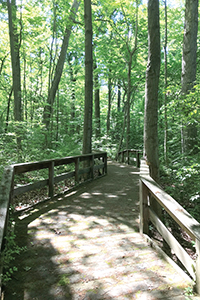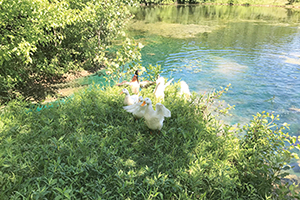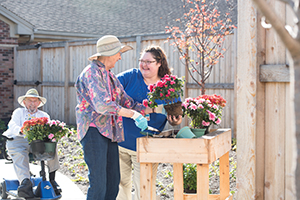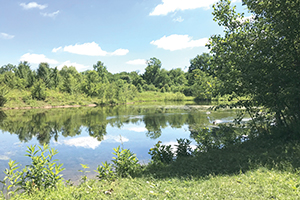By JULIE MINDA
For several years, residents and staff at Mercy Health – Oakwood Village in Springfield, Ohio, have been making an intentional effort to cultivate the 72-acre campus, to enhance its natural beauty and to make it more hospitable to wildlife. Their efforts recently were rewarded with the National Wildlife Federation designating the property a certified wildlife habitat.

Turner
Annette Turner, executive director of the eldercare campus says that maintaining the natural integrity of the "Oakwood Oasis," as it is known, by providing habitat for a variety of animals has benefits for humans, as well. "Oakwood's 72 acres of land are definitely full of wonderful wildlife for all of the residents and staff to enjoy. It's a beautiful place to take a walk and just breathe!"

Residents of Mercy Health – Oakwood Village proposed and helped plan this walking trail, which runs through woods on the Springfield, Ohio, campus.
Photos courtesy of Mercy Health
She adds, "We are so happy to provide a safe and natural environment for all the different birds and plants, deer, fox, squirrels, ducks and many other animals that all seem to know it's their home, too."
Green thumbs
Located about 80 miles northeast of Cincinnati, Oakwood Village has 125 independent living apartments, 46 assisted living apartments, an 86-bed skilled nursing center and retirement cottages. When it was founded in 1987, the campus was nestled in a woodland area. While the campus itself still is surrounded by some woods, much of the nearby area has been developed and is now suburban, according to information from Cheryl Hainey, director of legacy initiatives for Mercy Health's Springfield region.
But a sizeable proportion of the Oakwood Village campus has never been developed and that has been a draw for many residents and wildlife. Staff long have encouraged residents to get outside to interact with nature and view the animals that inhabit the meadows and woods and drink from the pond.
Residents also view the wildlife from the comfort of the buildings, enjoying the landscape through numerous large windows. Some residents have their own binoculars and swap tales about how many deer they've counted and species of birds they've seen. The campus plans to raise funds to build viewing posts outdoors.
In recent years a group of nature-loving residents and staff have worked to enhance the campus' natural features. A staff of five groundskeepers have worked hand-in-hand with residents who have given their time, creativity and money to the endeavor.
Residents started a community garden and planted wheelchair-accessible raised vegetable beds. While these beds weren't used this summer, staff and residents plan to revive them in the future. The gardens are close enough to the residential areas of the campus that wildlife generally leave them alone.

The campus is home to many animals, including these lively ducks.
Residents also have built bluebird nesting boxes which have been positioned in the prairie, and hung bird feeders from balconies at their residences. A group of residents proposed creating a trail through a wooded section of the campus. A contractor built the trail and footbridge using wheelchair-friendly composite material. Residents who are retired educators created curriculum identifying plants, insects and other natural features for those using the trail.
More than a decade ago, three residents, Ruth Rudawski and Lou and Ann Laux took the lead in restoring about 10 acres to indigenous prairie. Staff and residents walked the ground spreading seeds from native wildflowers and grasses, including prairie grass, black-eyed Susans, coneflowers and asters. Later, residents and staff sowed milkweed seed. The plant is essential to the life cycle of monarch butterflies, a species whose habitat is shrinking. The prairie is now self-seeding. Landscape crews maintain it, cutting it back each fall.

Residents Lou and Ann Laux work with Oakwood Village staff member Jenna Daulton to plant flowers in a wheelchair-accessible raised bed.
Lou Laux, a retired professor, has been in a skilled care unit at Oakwood Village since the start of this year. His wife Ann Laux, a retired administrative assistant, lives nearby in an independent living unit. The Lauxes have lived at the campus since 2005. Rudawski is a retired mental health professional who loves to garden.
Food, drink, shelter
The Lauxes initiated the certification process with the National Wildlife Federation this spring, working with Hainey to do so. Hainey says the trio quickly realized that "over the years, by simply cultivating a campus where residents, staff and families can commune with nature, many of the criteria (for certification) were met."
To earn certification, applicants — either organizations or individuals can apply — must show that their property has wildlife-friendly spaces that provide food, has at least one fresh water source, has habitats that offer shelter from weather and predators and places for the animals to raise their young. (Such shelters include wooded areas, prairies that provide ground cover, roosting boxes, evergreens and brush piles — Oakwood Village has all of the above.) To achieve certification, applicants also must show they use sustainable land management practices.

Wildlife drink and swim in the campus pond, which is about 3 acres in size.
Organizations and people also can join a "Million Pollinator Garden Challenge," to promote the health of honeybees and other pollinators. Oakwood Village is part of this challenge. The Lauxes and Hainey were notified in April that the campus had been certified as having a wildlife habitat and pollinator garden.
Wild Ohio
Campus staff and residents are thinking up new projects including capturing rainwater from roofs for reuse, removing non-native plants and animals, eliminating the use of chemical pesticides and composting to replace chemical fertilizers. Among the animals the facility has had to remove: coyotes. The species is not native to Ohio, but is present throughout the state, according to the Ohio Department of Natural Resources. Oakwood Village hired animal control professionals to trap and relocate those animals.
Hainey says Oakwood Village is helping to promote environmentalism and instill a love of nature in younger generations too. From time to time the campus welcomes local youth for intergenerational activities, such as trail walks.
Copyright © 2018 by the Catholic Health Association
of the United States
For reprint permission, contact Betty Crosby or call (314) 253-3490.